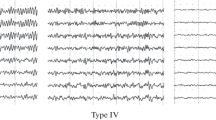Summary
In cats (anaesthetized with 100 mg/kg Phenobarbital), the effect of hypoxia on the levels of the energy-rich phosphates, the lactate/pyruvate system of the cerebral cortex, the cortical oxygen pressure and the electroencephalogram was measured.
During spontaneous respiration of 2–3,5% O2 in N2 with 3,5% CO2 the cortical oxygen pressure decreased to 0–2 mm Hg within 5–10 min. The EEG ceased within 10–20 min parallel with a significant fall of the Cr ∼ P/Cr-quotient. The quotient ATP/ADP decreased slightly but insignificant. After the end of the hypoxia the cortical potentials of the cerebral cortex reappeared at about the same time at which the Cr ∼ P/Cr-quotient returned to its initial value.
Respiration of 4–5% O2 in N2 with 3,5% CO2 caused no significant change of the Cr ∼ P/Cr-quotient, and the electroencephalogram did not disappear although the mean cortical O2-pressure decreased below 5 mm Hg.
The correlation of the movements of the Cr ∼ P/Cr-quotient in the course of the experiments to the disappearance and reappearance of the EEG points to a close functional connection of the energetic potential and the electrical activity of the cerebral cortex.
Zusammenfassung
An Katzen wurde die Wirkung von Hypoxie auf die Spiegel der energiereichen Phosphate und das Lactat/Pyruvat-System in der Großhirnrinde, den corticalen Sauerstoffdruck und das Elektrencephalogramm untersucht.
Während Atmung von 2–3,5% O2 in N2 mit 3,5% CO2 sank innerhalb von 5–10 min der corticale Sauerstoffdruck auf 0–2 mm Hg ab, nach 10–20 min erlosch das Elektrencephalogramm parallel zu einem deutlichen Absinken des Cr ∼ P/Cr-Quotienten, während das ATP/ADP-Verhältnis nicht signifikant erniedrigt war. Nach Ende der Hypoxie traten mit der Normalisierung des Cr ∼ P/Cr-Quotienten wieder elektrische Potentiale in der Hirnrinde auf.
Bei Atmung von 4–5% O2 in N2 mit 3,5% CO2 war der Cr ∼ P/Cr-Quotient nicht signifikant verändert, und es kam trotz starken Abfalls des corticalen Sauerstoffdrucks nicht zu einem Erlöschen des Elektrencephalogramms.
Die zeitliche Korrelation in den Bewegungen des Cr ∼ P/Cr-Quotienten zum Erlöschen und Wiedererscheinen des EEG weist auf eine enge funktionelle Verknüpfung des energetischen Potentials und der elektrischen Aktivität der Hirnrinde hin.
Similar content being viewed by others
Literatur
Betz, E., u. R. Kozak: Der Einfluß der Wasserstoffionenkonzentration auf die Regulation der corticalen Durchblutung. Pflügers Arch. ges. Physiol. (im Druck).
Chance, B., and B. Schoener: Correlation of oxidation—reduction changes of intracellular reduced pyridine-nucleotide and changes in electro-encephalogram of the rat in anoxia. Nature (Lond.) 195, 956–958 (1962).
Clark, L. C., jr., R. Wolf, D. Granger, and Z. Taylor: Continuous recording of blood oxygen tensions by polarography. J. appl. Physiol. 6, 189–193 (1953).
Gastaut, H., H. Fischgold, and J. S. Meyer: Conclusions of the international colloquium on anoxia and the EEG. In: Cerebral anoxia and the electroencephalogram, p. 599–608. Ed. by H. Gastaut and J. S. Meyer. Springfield, Ill.: Ch. C. Thomas 1961.
Gleichmann, U., D. H. Ingvar, D. W. Lübbers, B. K. Siesjö, and G. Thews: Tissue PO2 and PCO2 of the cerebral cortex, related to blood gas tensions. Acta physiol. scand. 55, 127–138 (1962).
——, u. D. W. Lübbers: Die Messung des Sauerstoffdruckes in Gasen und Flüssigkeiten mit der Pt-Elektrode unter besonderer Berücksichtigung der Messung im Blut. Pflügers Arch. ges. Physiol. 271, 431–455 (1960).
Grunewald, W.: Theoretische Analyse der Sauerstoffversorgung der Gewebe. In: Die Sauerstoffversorgung der Gewebe. Bad Oeynhausener Gespräche IX, 1965. Berlin, Heidelberg, New York: Springer (im Druck).
Gurdjian, E. S., J. E. Webster, and W. E. Stone: Cerebral constituents in relation to blood gases. Amer. J. Physiol. 156, 149–157 (1949).
Hohorst, H. J.: Metabolitgehalte und Metabolitgleichgewichte in der quergestreiften Muskulatur der Ratte. Habilitationsschrift, Med. Fakultät, Marburg/Lahn 1961.
—— Einige Bemerkungen über Metabolitgleichgewichte und Strukturen im cytoplasmatischen Lösungsraum. In: Funktionelle und morphologische Organisation der Zelle, S. 194–208. Wissenschaftliche Konferenz der Gesellschaft Deutscher Naturforscher und Ärzte in Rottach-Egern 1962. Berlin, Göttingen, Heidelberg: Springer 1963.
--, u. H. Bartels: Unveröffentlichte Versuche.
——, and H. Bartels: Studies on the creatine kinase equilibrium in muscle and the significance of ATP and ADP levels. Biochem. biophys. Res. Commun. 7, 142–146 (1962).
Ingvar, D. H., D. W. Lübbers, and B. Siesjö: Measurement of oxygen tension on the surface of the cerebral cortex of the cat during hyperoxia and hypoxia. Acta physiol. scand. 48, 373–381 (1960).
Jacobs, H., H. W. Heldt, and M. Klingenberg: High activity of creatine kinase in mitochondria from muscle and brain and evidence for a separate mitochondrial isoencyme of creatine kinase. Biochem. biophys. Res. Commun. 16, 516–521 (1964).
Kety, S. S., and C. F. Schmidt: The effects of altered arterial tensions of carbon dioxide and oxygen on cerebral blood flow and cerebral oxygen consumption of normal young men. J. clin. Invest. 27, 484–492 (1948).
Kugler, J.: Elektroencephalographie in Klinik und Praxis. Eine Einführung. Stuttgart: G. Thieme 1963.
Lübbers, D. W.: Normale und kritische Sauerstoffversorgung des Gehirns. In: Die Sauerstoffversorgung der Gewebe. Bad Oeynhausener Gespräche IX, 1965. Berlin, Heidelberg, New York: Springer (im Druck).
Noell, W., u. M. Schneider: Über die Durchblutung und die Sauerstoffversorgung des Gehirns. IV. Mitteilung. Die Rolle der Kohlensäure. Pflügers Arch. ges. Physiol. 247, 514–527 (1944).
Schmahl, F. W., E. Betz, H. Talke u. H. J. Hohorst: Energiereiche Phosphate und Metabolite des Energiestoffwechsels in der Großhirnrinde der Katze. Biochem. Z. 342, 518–531 (1965).
Scholander, P. F.: Analyzer for accurate estimation of respiratory gases in one-half cubic centimeter samples. J. biol. Chem. 167, 235–250 (1947).
Wyke, B.: Brain function and metabolic disorders. The neurological effects of changes in hydrogen ion concentration. London: Butterworth & Co., Ltd. 1963.
Author information
Authors and Affiliations
Additional information
Mit Unterstützung der Deutschen Forschungsgemeinschaft.
Auszugsweise vorgetragen auf der Herbsttagung der Gesellschaft für Physiologische Chemie, Oktober 1965, in Berlin.
Stipendiat der Deutschen Forschungsgemeinschaft.
Rights and permissions
About this article
Cite this article
Schmahl, F.W., Betz, E., Dettinger, E. et al. Energiestoffwechsel der Großhirnrinde und Elektrencephalogramm bei Sauerstoffmangel. Pflügers Archiv 292, 46–59 (1966). https://doi.org/10.1007/BF00413124
Received:
Issue Date:
DOI: https://doi.org/10.1007/BF00413124




